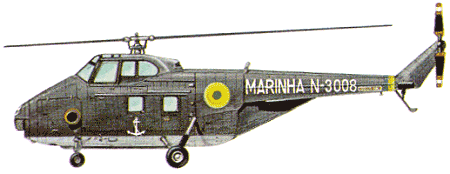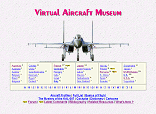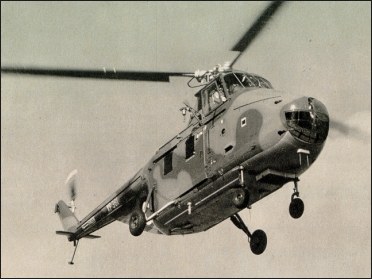|
|
The first S-55s received by the Royal Navy in 1950 were built by Sikorsky, but Westland acquired a license in 1950 and the first British-made S-55 flew at Yeovil in November 1952. Like the American models, the first Whirlwinds had Pratt & Whitney engines and were delivered to No.705 Squadron based at Gosport.
The RAF also ordered this helicopter for transport and rescue missions: the Whirlwind HAR Mk.2 (the same as the naval version except for some differences in equipment) joined the Transport and Coastal Command Units from 1955. With Wright R.1300 engines, the Whirlwind Mk.3 went into production for the Royal Navy in 1953 and operated for many years from both ship and shore bases. The subsequent RAF HAR Mk.4 version was modified for use in the tropics and fitted with a new variant of the Pratt & Whitney R-1340. It was used in Malaysia.
When Westland began producing the S-55, it specified that the American engine would be used until a more suitable British powerplant was available. To meet this requirement, Alvis developed a double radial called the Leonides Major, which delivered 882hp derated to 750hp. The re-engined Whirlwind flew in 1955. It was followed in 1956 by the Mk.7 version intended to replace the old Fairey Gannet antisubmarine aircraft.
Meanwhile, Westland had thought of adapting a turbine engine for the Whirlwind. The aircraft was first given a General Electric T.58 and then the more powerful D.H. Gnome turbine. The turbine-powered Whirlwind Series 3 flew in February 1959 and introduced a new nose profile which offered better visibility from the cockpit than the piston engine version. The Whirlwind could carry ten men or six stretchers, or a comparable load.
The RAF adopted the Whirlwind Mk.10 version in April 1960. More than 400 Whirlwinds were built, of which nearly 100 were exported to the following countries: Austria, Brazil, Canada, Cuba, France, Ghana, Jordan, Iran, Kuwait, Spain, Saudi Arabia and Yugoslavia. G.Apostolo "The Illustrated Encyclopedia of Helicopters", 1984

Westland obtained the licence to build the S-55 from Sikorsky in November 1950. The Series 1 and 2, powered respectively by a Pratt & Whitney R-1340 or Wright R-1300 engine or the 755hp Alvis Leonides Major 755, were used for both civil and military work.
The turbine-powered S-55 made its first flight as the Whirlwind Series 3 in February 1959, powered by a General Electric T58. At the end of the year a Series 3 flew with a 1050shp Bristol Siddeley Gnorne free-turbine - the licence-built version of the T58.
Like the S-55, the Series 3 has a single door on the left side. The pilot and co-pilot sit above and behind the engine which places their cabin directly under the centreline of the main rotor. The rotor is hydraulically operated for both cyclic and collective pitch controls. Forward vision for landing was not ideal in earlier versions of the Whirlwind since the engine housing was in the nose. The turbine version was better since, though the nose was longer, it was at a more raked angle. Unlike the US turbine-powered S-55, the Whirlwind Series 3 has its engine exhaust on the left side almost immediately above the forward wheel, which can make cargo loading slightly hazardous if the engine is running or the exhaust hot. The turbine engine can be retrofitted to Series 1 and 2 machines.
The Whirlwind can carry up to ten passengers, six stretchers or a freight load. The Series 2 machines in service with BEA were fitted with floats as well as wheels for use off inland waterways. Few Whirlwinds are in civil use in the 1980s. Bill Gunston "The Illustrated Encyclopedia of Commercial Aircraft", 1980
FACTS AND FIGURES- Westland built a total of 364 S-55s under
licence between 1953 and 1966, including
68 WS-55 civil aircraft. - Bristow Helicopters' Series 1s were used
for 'flying crane' and oil rig support duties. - British airline BEA used WS-55s between
central London and Heathrow airport. - Most turbine-powered WS-55 Series 3s
were converted from piston-engined
Series 1s and 2s. - WS-55s were used from the 1950s in the
Falkland Islands for whaling operations. - In 1955 a Whirlwind on delivery was flown
5000km to the Persian Gulf.
| Technical data for Westland "Whirlwind 3"
Crew: 2,
passengers: 8-10,
engine: 1 x Bristol Siddeley "Gnome" turboshaft, rated at 795kW,
rotor diameter: 16.2m,
length: 19.0m,
height: 4.0m,
take-off weight: 3629kg,
empty weight: 2159kg,
cruising speed: 167km/h,
rate of climb: 6.1m/s,
service ceiling: 4870m,
range with max fuel: 834km,
range with max payload: 174km,
service ceiling: 4870m
|
| Pete Bogué, e-mail, 08.08.2010 | reply |
I flew Whirwind 2 /4s at 'B' Flight No 228 SAR Squadron, RAF Leconfield in the early sixties. We re-equipped with the Mk 10 Turbine-powered aircraft (mostly re-built 2 /4s). The cabin door was on the right-hand side and the jet exhaust on the right. I later flew on No 103 Squadron based at Seletar, Singapore. However, we spent most of our time in either Malaya or Borneo during the Indonesian Confrontation. The 'brochure' says the aircraft can carry ten soldiers or six stretchers, but that was nonsense on operations and we usually managed five or six fully equipped soldiers. Ghurkas weighed more than the others! The WW 10 was nice to fly, very manoeuvrable and the automatic throttle control took the sweat out of chopper flying (no need to do the 'one-armed paper hanger' act of the earlier piston-engined Whirlwinds. I would not have missed Search and Rescue, or Borneo and Malaya for anything. It was fun, fun, fun all the way! So, I'm 79 and some now and the last time I flew it was in a Tiger Moth!! | | Pete Bogue, e-mail, 08.08.2010 | reply |
Just noticed 'howler' in my previous post. Just to be sure, the door was on the right and the jet exhaust on the left! The later Wessex had twin Gnomes and thus an exhaust on both sides. The view to the right from the pilots seat was often hazy due to the exhaust heat! The Gnome was capable of giving about 1050 shaft horse power, but was de-rated in the WW10 to around 850 because the main rotor gearbox and drive train could not absorb more power. A bit more range, a tad more speed and the old Whirlybird would have taken some beating as a battlefield chopper. | | Keith Cannon, e-mail, 22.09.2010 | reply |
Just noticed the posts from Pete Bogué.I was a Jnr Tech based at Labuan from Nov 63 to Nov 64, and managed to get a job as a crewman on 103 Squadron Whirlwind 10s. He may well not remember me from that far back, however I did fly with him on XR 478 and XR 479 from the 7th to 29th October 1964. I well remember sitting in the door with my feet dangling out either high above the rain forest or way below the tree tops. The WW10 was an exciting aircraft to fly in and did not give me many problems when it came to servicing them in the field. The year I spent flying on the WW10 was without doubt the best fun that I have ever had. Given the chance I would do exactly the same tomorrow - even though I am now a bit long in the tooth!! |
| Jamie MacAlister, e-mail, 12.10.2010 | reply |
I am presently a Lecturer / Instructor with Air Service Training (Engineering) at Perth Airport, Scone in Scotland. I thought you may like to know we have a Whirlwind HAS Mk 9 in the hangar (she is used extensively to teach young Helicopter engineers) amongst other types. XL 875 is her Royal Navy Service number. | | Terry Jones, e-mail, 20.02.2011 | reply |
Just seen Peter Bogué's post. I well remember flying with him as crewman on 103 Sqn at Seletar and from Kuching. Good to know that he is still alive. I have memories of my time on helicopters. |
| Bill Fletcher, e-mail, 07.03.2011 | reply |
When I arrived at Seletar at the end of 1962 103 sqdn consisted of 1 Flt /Sgt, 1Ch /Tech and 2 corporals including me. We built the ground equipment then assisted in building the aircraft from boxesIwas on the party which took the aiorcraft to Borneo on HMS Albion. Happy days! | | Lou, e-mail, 10.08.2011 | reply |
Did XD164 Mk.10 finish up on gate guard somewhere? after it was retrieved from Holyhead harbour. | | davie mcelhinney, e-mail, 22.10.2013 | reply |
can anyone tell me did the westland whirlwind helicopter
ever fly an operational roll in northern Ireland. either
before operation banner or as part of the operation
thankyou | | Ray Butchart, e-mail, 22.07.2010 | reply |
Looking for the numbers and code letters for HAR10 Whirlwinds used at 84 Squadron Nicosia in late 1970s | |
| | DAVID ANGEL, e-mail, 02.01.2010 | reply |
CAN YOU TELL ME THE SERIAL NUMBER OF THE MK10 AT RAAF
BUTTERWORTH
I SERVED ON BOARD THIS HELICOPTER WHILST SERVING WITH THE REGIMENT (I SQUADRON) | | DS Mallock, e-mail, 30.10.2009 | reply |
The cabin door for all S-55s is on the righthand side! | | paul, e-mail, 26.05.2009 | reply |
I worked on the last operational Mk7 at RAF Old Sarum. We where a Royal Navy Dtachment (Flee Air Arm)Using the helo as a trials aircraft for tactical innovations for helo`s. The abiding memory I have was of putting the handle in the front of the engine and turning it 3x30 times to put oil round the engine prior to stating first time daily. Comments like winding the rubber band where always being thrown our way when operating at varios RAF or fleet Air Arm establishments | | kiran, e-mail, 20.04.2009 | reply |
will u send me model sketch of your project let me know something about your project please | | maurice gillon, e-mail, 07.12.2007 | reply |
Hi, I was stationed in Malaya with the RAF in the early 50's working with the HAR Mk 4 and wonder if you know where I could purchase a print of this model. |
|
| |
|
Do you have any comments ?
|
| 
Virtual Aircraft Museum

All the World's Rotorcraft
|







 Terry Jones
Terry Jones

Dear Keith,
Thank you for sharing your memories of Peter Bogué, my father-in-law, here. We miss him very much.
Chari Bogué
reply